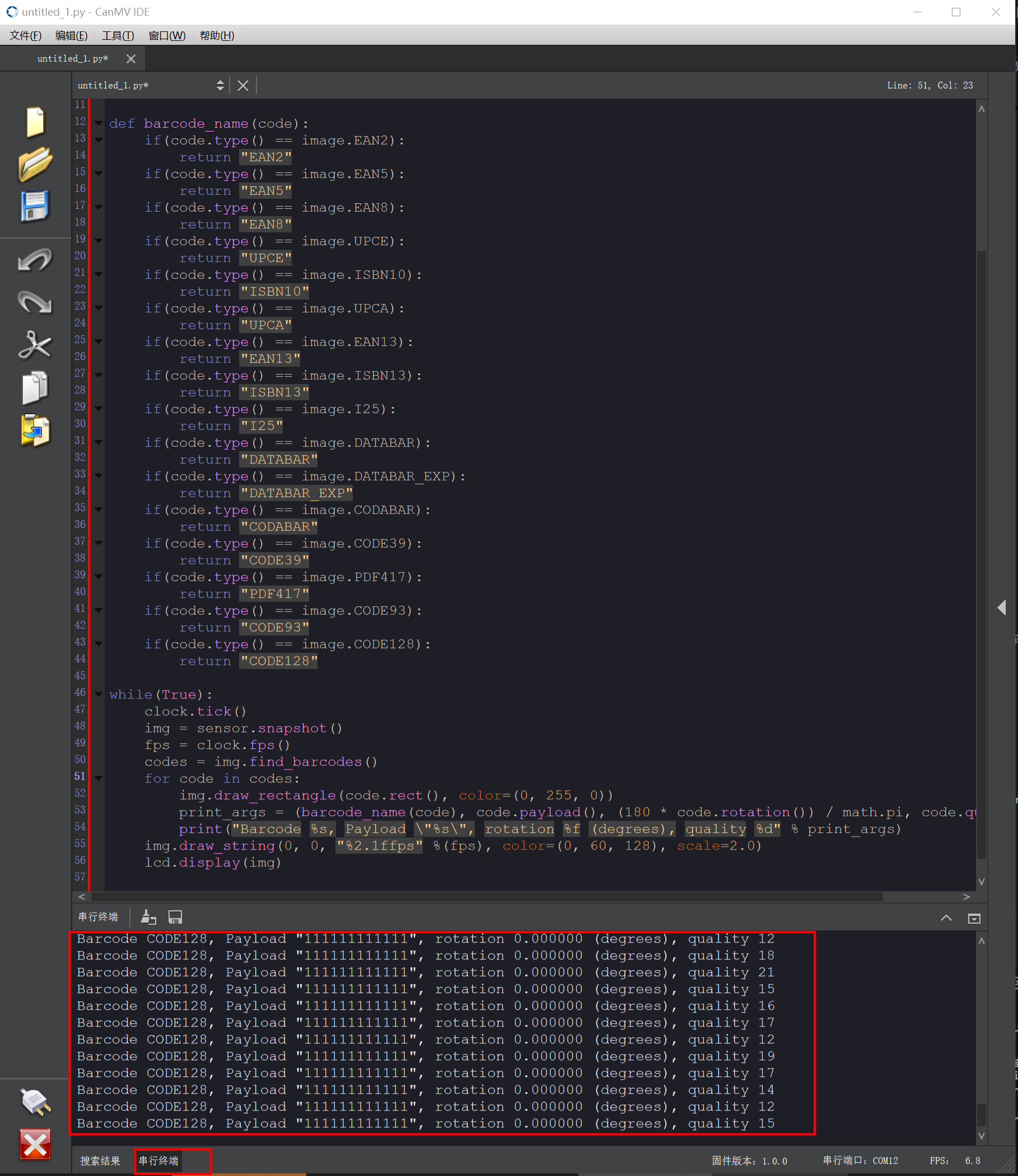3、条形码识别实验
大约 2 分钟
例程代码
import sensor, image, time, math, lcd
lcd.init()
sensor.reset()
sensor.set_pixformat(sensor.RGB565) #GRAYSCALE
sensor.set_framesize(sensor.QVGA)
sensor.skip_frames(time = 100)
sensor.set_auto_gain(False)
sensor.set_auto_whitebal(False)
clock = time.clock()
def barcode_name(code):
if(code.type() == image.EAN2):
return "EAN2"
if(code.type() == image.EAN5):
return "EAN5"
if(code.type() == image.EAN8):
return "EAN8"
if(code.type() == image.UPCE):
return "UPCE"
if(code.type() == image.ISBN10):
return "ISBN10"
if(code.type() == image.UPCA):
return "UPCA"
if(code.type() == image.EAN13):
return "EAN13"
if(code.type() == image.ISBN13):
return "ISBN13"
if(code.type() == image.I25):
return "I25"
if(code.type() == image.DATABAR):
return "DATABAR"
if(code.type() == image.DATABAR_EXP):
return "DATABAR_EXP"
if(code.type() == image.CODABAR):
return "CODABAR"
if(code.type() == image.CODE39):
return "CODE39"
if(code.type() == image.PDF417):
return "PDF417"
if(code.type() == image.CODE93):
return "CODE93"
if(code.type() == image.CODE128):
return "CODE128"
while(True):
clock.tick()
img = sensor.snapshot()
fps = clock.fps()
codes = img.find_barcodes()
for code in codes:
img.draw_rectangle(code.rect(), color=(0, 255, 0))
print_args = (barcode_name(code), code.payload(), (180 * code.rotation()) / math.pi, code.quality())
print("Barcode %s, Payload \"%s\", rotation %f (degrees), quality %d" % print_args)
img.draw_string(0, 0, "%2.1ffps" %(fps), color=(0, 60, 128), scale=2.0)
lcd.display(img)实验准备
- 通过usb线将K210与电脑连接。
- 准备一张条形码。
- 打开CanMV IDE,执行上面的例程代码。
实验结果
- 等待系统初始化完成后, LCD显示摄像头画面,用摄像头拍摄条形码,则会将条形码框出来。

- 并且在IDE 底部的串行终端将条形码信息打印出来。

例程代码讲解
- 导入相关库,并初始化摄像头和LCD显示屏。
import sensor, image, time, math, lcd
lcd.init()
sensor.reset()
sensor.set_pixformat(sensor.RGB565) #GRAYSCALE
sensor.set_framesize(sensor.QVGA)
sensor.skip_frames(time = 100)
sensor.set_auto_gain(False)
sensor.set_auto_whitebal(False)
clock = time.clock()- 转化条形码的类型名称为字符串。
def barcode_name(code):
if(code.type() == image.EAN2):
return "EAN2"
if(code.type() == image.EAN5):
return "EAN5"
if(code.type() == image.EAN8):
return "EAN8"
if(code.type() == image.UPCE):
return "UPCE"
if(code.type() == image.ISBN10):
return "ISBN10"
if(code.type() == image.UPCA):
return "UPCA"
if(code.type() == image.EAN13):
return "EAN13"
if(code.type() == image.ISBN13):
return "ISBN13"
if(code.type() == image.I25):
return "I25"
if(code.type() == image.DATABAR):
return "DATABAR"
if(code.type() == image.DATABAR_EXP):
return "DATABAR_EXP"
if(code.type() == image.CODABAR):
return "CODABAR"
if(code.type() == image.CODE39):
return "CODE39"
if(code.type() == image.PDF417):
return "PDF417"
if(code.type() == image.CODE93):
return "CODE93"
if(code.type() == image.CODE128):
return "CODE128"- 新建while循环,将摄像头采集的画面进行条形码分析,如果图像中有条形码,则将条形码的信息打印出来,并用绿色框出条形码的位置。
while(True):
clock.tick()
img = sensor.snapshot()
fps = clock.fps()
codes = img.find_barcodes()
for code in codes:
img.draw_rectangle(code.rect(), color=(0, 255, 0))
print_args = (barcode_name(code), code.payload(), (180 * code.rotation()) / math.pi, code.quality())
print("Barcode %s, Payload \"%s\", rotation %f (degrees), quality %d" % print_args)
img.draw_string(0, 0, "%2.1ffps" %(fps), color=(0, 60, 128), scale=2.0)
lcd.display(img)